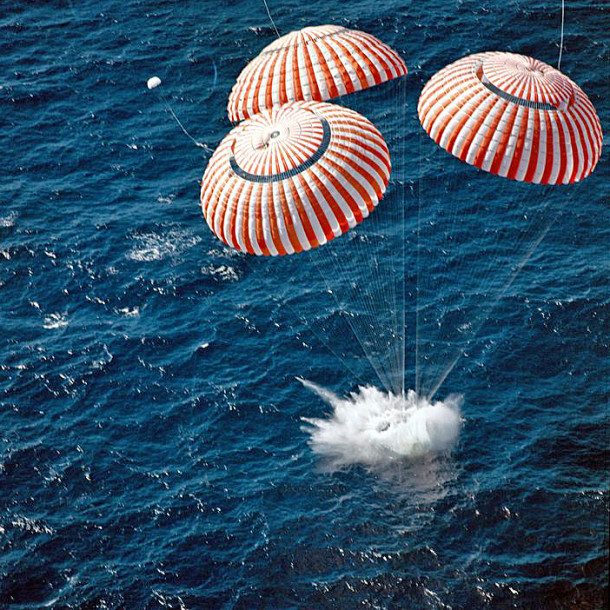
Fifty years ago today, Apollo 11 astronauts Neil Alden Armstrong, Edwin Eugene Aldrin, Jr., and Michael Collins returned safely to the Earth to bring to a close the first space mission to land men on the lunar surface. With their safe return, President John F. Kennedy’s inspired national goal of landing men on the Moon and bringing them safely home before the end of the 1960’s was successfully accomplished.
The crew of Apollo 11 and their celestial chariot, Columbia, splashed-down in the Pacific Ocean at a point 812 nautical southwest of Hawaii. The epic journey to the Moon and back covered 952,700 nautical miles. Mission total elapsed time was 195 hours, 18 minutes, and 35 seconds.
Following splashdown, the Apollo 11 astronauts and their Command Module Columbia were brought aboard the USS Hornet (CV-12). Concerned that they would infect Earthlings with lunar pathogens, NASA quarantined the astronauts in the Mobile Quarantine Facility (MQF), which was a converted vacation trailer.
The Hornet steamed for Hawaii and transferred the MQF for airlift to Ellington Air Force Base, Texas. Following landing, the MQF and its heroic occupants were transported to the Johnson Spacecraft Center (MSC) in Houston, Texas. Once there, the astronauts and several medical staff were transferred from the MQF to more substantial accommodations known as the Lunar Receiving Laboratory (LRL).
Combined stay time in the MQF and LRL was 21 days. During their forced confinement, Armstrong, Aldrin, and Collins debriefed the Apollo 11 mission, rested, and mused about their unforgettable experiences at the Moon.
The Apollo 11 astronauts were released from the LRL on Thursday, 13 August 1969, having never contracted nor transmitted a lunar disease.
Parenthetically, Apollo 11 brought the first geologic samples from the Moon back to Earth. Roughly 48 pounds of lunar rock samples were collected. Two primary types of rocks, basalts and breccias, were found at the Sea of Tranquility landing site. Subsequent analyses indicated that these samples neither contained water nor provided evidence for living organisms at any time in the history of the Moon.


Comments
Fifty years ago today, Apollo 11 astronauts Neil Alden Armstrong, Edwin Eugene Aldrin, Jr., and Michael Collins returned safely to the Earth to bring to a close the first space mission to land men on the lunar surface. Even by today’s standards, this is an awesome technical endeavor. What an accomplishment!
Share this post: